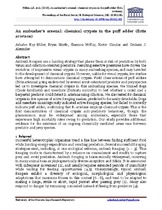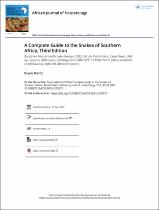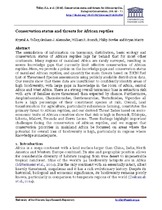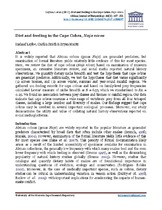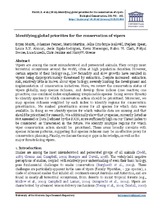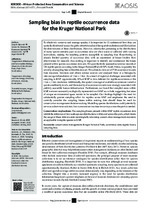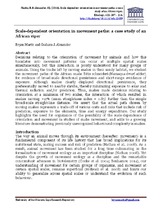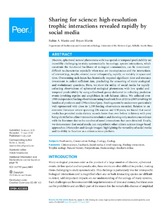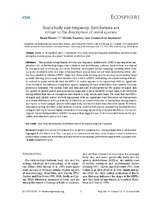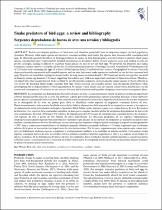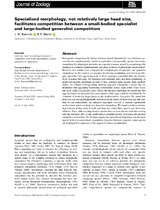Browsing Research Articles (Bioversity and Conservation Biology) by Author "Maritz, Bryan"
Now showing items 1-11 of 11
-
An ambusher’s arsenal: chemical crypsis in the puff adder (Bitis arietans)
Miller, Ashadee Kay; Maritz, Bryan; McKay, Shannon; Glaudas, Xavier; Alexander, Graham J. (The Royal Society, 2015)Ambush foragers use a hunting strategy that places them at risk of predation by both visual and olfaction-oriented predators. Resulting selective pressures have driven the evolution of impressive visual crypsis in many ... -
A complete guide to the snakes of Southern Africa
Maritz, Bryan (African Journal of Herpetology, 2023)Background: The new edition of A Complete Guide to the Snakes of Southern Africa represents the third iteration in a series of books that started three decades ago. The latest edition replaces the 2004 edition (Marais ... -
Conservation status and threats for African reptiles
Tolley, Krystal A.; Alexander, Graham J.; Branch, William R.; Bowles, Philip; Maritz, Bryan (Elsevier, 2016)The assimilation of information on taxonomy, distribution, basic ecology and conservation status of Africa's reptiles lags far behind that for most other continents. Many regions of mainland Africa are rarely surveyed, ... -
Diet and feeding in the Cape Cobra, Naja nivea
Layloo, Inshaaf; Smith, Caitlin; Maritz, Bryan (Taylor & Francis, 2017)It is widely reported that African cobras (genus Naja) are generalist predators, but examination of formal literature yields relatively little evidence of this for most species. Here, we review the diet of cape cobras (Naja ... -
Identifying global priorities for the conservation of vipers
Maritz, Bryan; Penner, Johannes; Martins, Marcio (Elsevier, 2016)Vipers are among the most misunderstood and persecuted animals. They occupy most terrestrial ecosystems around the world, often at high population densities. However, certain aspects of their biology (e.g., low fecundity ... -
Sampling bias in reptile occurrence data for the Kruger National Park
Barends, Jody; Pietersen, Darren; Zambatis, Guinevere; Tye, Donovan; Maritz, Bryan (AOSIS, 2020)To effectively conserve and manage species, it is important to (1) understand how they are spatially distributed across the globe at both broad and fine spatial resolutions and (2) elucidate the determinants of these ... -
Scale-dependent orientation in movement paths: a case study of an African viper
Maritz, Bryan; Alexander, Graham J. (Wiley, 2016)Decisions relating to the orientation of movement by animals and how this translates into movement patterns can occur at multiple spatial scales simultaneously, but this interaction is poorly understood for many groups of ... -
Sharing for science: High-resolution trophic interactions revealed rapidly by social media
Maritz, Robin A.; Maritz, Bryan (PeerJ, 2020)Discrete, ephemeral natural phenomena with low spatial or temporal predictability are incredibly challenging to study systematically. In ecology, species interactions, which constitute the functional backbone of ecological ... -
Snake body size frequency distributions are robust to the description of novel species
Maritz, Bryan; Kgaditse, Mimmie; Alexander, Graham John (Ecological Society of America, 2016)The accurate interpretation of body size frequency distributions (BSFDs) has important implications for understanding large-scale ecological and evolutionary patterns because they are shaped by ecological and evolutionary ... -
Snake predators of bird eggs: A review and bibliography
Barends, Jody M.; Maritz, Bryan (Wiley, 2022)Snakes are frequent predators of bird nests and therefore potentially have an important impact on bird population dynamics. However, while many species are known to consume nestlings and chicks, few species have been ... -
Specialized morphology, not relatively large head size, facilitates competition between a small-bodied specialist and large-bodied generalist competitors
Barends, Jody, M; Maritz, Bryan (Journal of Zoology, 2021)Interspecific competition for limited resources should theoretically occur between species that are morphologically similar to each other. Consequently, species that reduce competition by adapting to specialize on a specific ...

